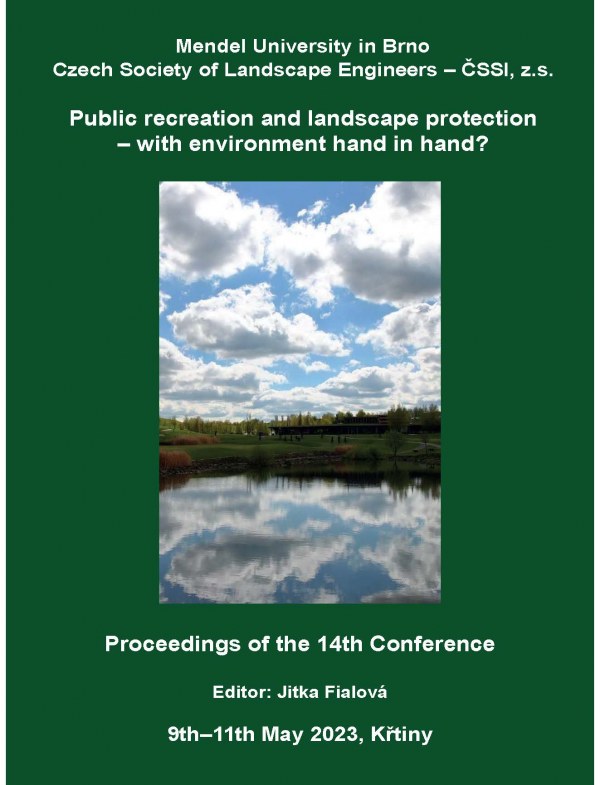
DOI: 10.11118/978-80-7509-904-4-0316
THE IMPORTANCE AND FUNCTIONS OF RIPARIAN STANDS OF THE RECREATIONAL WATER RESERVOIR POČÚVADLO IN ŠTIAVNICKÉ VRCHY
- Mariana Jakubisová, Matúš Jakubis
The recreational water reservoir Počúvadlo, which was built in the years 1775-1779, is located in the Štiavnické vrchy Protected Landscape Area near the town of Banská Štiavnica. This water reservoir, as a part of the historical mining water management system, is the most visited and used for recreation out of the 26 preserved reservoirs in the vicinity of Banská Štiavnica. Počúvadlo water reservoir covers an area of 12.13 hectares and is a popular summer and winter recreation center and the venue for various cultural and sports events in this region. An important part of the Počúvadlo water reservoir are the riparian stands, which have several functions. These functions are mainly related to the protection of banks from erosion (abrasion), create suitable space and conditions for recreation and relaxation, affect the water quality in the reservoir, etc. In 1993, town Banská Štiavnica, together with the technical monuments in the vicinity (including the unique water management system of water reservoirs), was entered into the UNESCO World Cultural and Natural Heritage List.
Keywords: lacustrine vegetation, erosion control, water quality, tourism
pages: 316-320, Published: 2023, online: 2023
References
- Collective of authors. (2002). Riparian Areas - Functions and Strategies for Management. Washington, D. C.: National Academy Press, 436 p.
- Jakubis, M. (2016). Evaluation of visitors satisfaction at lake Počúvadlo in Protected Landscape Area Štiavnické vrchy during sommer recreation. In: Fialová, J., Pernicová, D. (eds.). Public recreation and landscape protection - with nature hand in hand. Conference proceeding. Brno: Mendel University In Brno, p. 52-56.
- Jakubis, M. (2019). Quantification of abrasion as a bazis for revitalization ot the banks of recreational water reservoir visitors satisfaction Počúvadlo. In: Fialová, J. (ed.). Public recreation and landscape protection - with nature hand in hand. Conference proceeding. Brno: Mendel University In Brno, p. 303-307.
- Jakubisová, M. (2011). Research of soil-protection function of riparian stands. [in SlovaK: Výskum pôdoochrannej funkcie brehových porastov]. Ph.D. Thesis. Zvolen: Technická univerzita vo Zvolene, 159 p.
- Majorošová, M., Reháčková T. (2022). Planting greenery in the country. [in Slovak: Výsadby zelene v krajine]. Bratislava: STU v Bratislave, Stavebná fakulta, 131 p.
- Rasmussen, G. A., Padgett, W. (1994). Recreational Effect of Riparian Areas. Natural Resources and Environmental Issues, Vol. 1, Article 7.
- Riis,T., Kelly-Quin, M., Aguiar, F. C., Manolaki, P., Bruno, D., Bejarano M. D., Clerici, N., Fernandes, M. R., Franco, J. C., Pettit, N., Portela, A. P., Tammeorg, O., Tameorg, P., Rodriguez-Gonzales P. M., Dufour, S. (2020). Global Overview of Ecpsystem Services Provided by Riparian Vegetation. BioScience, 70(6), 501-514.
 Go to original source...
Go to original source... - Saklaurs, M., Liepina A. A., Elferts, D., Jansons, A. (2022). Social Perception of Riparioan Forests. Sustainability, 14(15), 9302.
 Go to original source...
Go to original source... - Simon, A., Collison, A. J. C. (2002). Quantifying the mechanical and hydrologic effects of riparian vegetation on streambank stability. Earth Surface Processes and Landforms, 27(5): 527-546.
 Go to original source...
Go to original source... - Šlezingr, M. (2011). Bank erosion - Possible ways of bank stabilization. [in Czech: Břehová abraze - možnosti stabilizace břehů]. Brno: Mendelova Univerzita v Brně, 172 p.
- Valtýni, J. (1981). Determination, establishment and management of riparian stands according to their functions. [in Slovak: Vyčleňovanie, zakladanie a obhospodarovanie brehových porastov podľa ich funkciíG. Bratislava: Príroda, 41 p.
- Zingraff-Hamed, A., George, F. N., Lupp, G., Pauleit, S. (2022). Effects of recreational use on restored urban floodplain vegetation in urban areas. Urban Forestry & Urban Greening, 67(1), 127444.
 Go to original source...
Go to original source...


